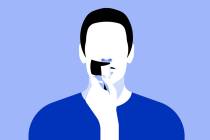Are there early warning signs?
No one called Nancy Lanza a bad parent. In fact, she stayed home as dedicated caregiver to her bright but troubled 20-year-old son Adam, who on Friday took her guns, shot her four times in the head as she was sleeping, drove her car to an elementary school he had attended years before in Newtown, Conn., and killed 26 more people, most of them small children.
The New York Daily News interviewed a friend who talked regularly with the divorced mom at a neighborhood tavern. She had said recently that Adam was getting worse, that he was burning himself with a cigarette lighter (he had a low sensitivity to pain), that she feared she was "losing him."
The friend asked Nancy Lanza if she was getting Adam some help. She said she was.
Should someone have noticed and intervened more effectively?
There have been predictable calls for more gun control after last week's horrific crime, which ended when 20-year-old Adam Lanza took his own life upon hearing sirens. But not enough emphasis has been paid to other patterns that may link many of these young shooters.
Many were using - or had just stopped using - prescribed psychoactive drugs at the time they committed their crimes.
Steven Kazmierczak, 27, a former graduate student who was armed with a 12-gauge shotgun and three pistols, killed six people before turning his weapon on himself at Northern Illinois University in 2008. Kazmierczak had recently stopped taking his Prozac.
In, 2005 on the Red Lake Indian Reservation in Minnesota, 16-year-old Jeff Weise was under the influence of the antidepressant Prozac when he shot and killed nine people before committing suicide.
Eighteen-year-old Eric Harris was on the antidepressant Luvox when he and his partner Dylan Klebold killed 12 classmates and a teacher and wounded 23 others before taking their own lives in what was then the bloodiest American school massacre to date, in 1999 at Columbine High School in Littleton, Colo. The toxicological results of Dylan Klebold's autopsy were never made public.
On May 21, 1998, in Springfield, Ore., 15-year-old Kip Kinkel murdered his own parents and then proceeded to school where he opened fire on students in the cafeteria, killing two and wounding 22. Kinkel had been on Prozac.
John Fund, national-affairs columnist for National Review Online, urges that rather than fruitlessly repeating the old gun control debate, "We would be better off debating ... the laws that make it difficult to control people with mental illness."
A lengthy study by Mother Jones magazine found that at least 38 of the 61 mass shooters in the past three decades "displayed signs of mental health problems prior to the killings," Mr. Fund reports. New York Times columnist David Brooks and Cornell Law School professor William Jacobsen have both suggested ACLU-inspired laws that make it difficult to intervene and identify potentially dangerous people should be loosened.
In a free country, we can't and shouldn't envision curbing the liberties of every troubled young man. But have we looked closely for links between these crimes, mental disorders and the prescription of antidepressants and other psychoactive drugs? Do our laws make it impossible for health care providers to advise police of potentially dangerous patients?
Instead of focusing solely on the icon of the gun, maybe it's time to discuss both defending our kids and figuring out what's driving these young men crazy.

















